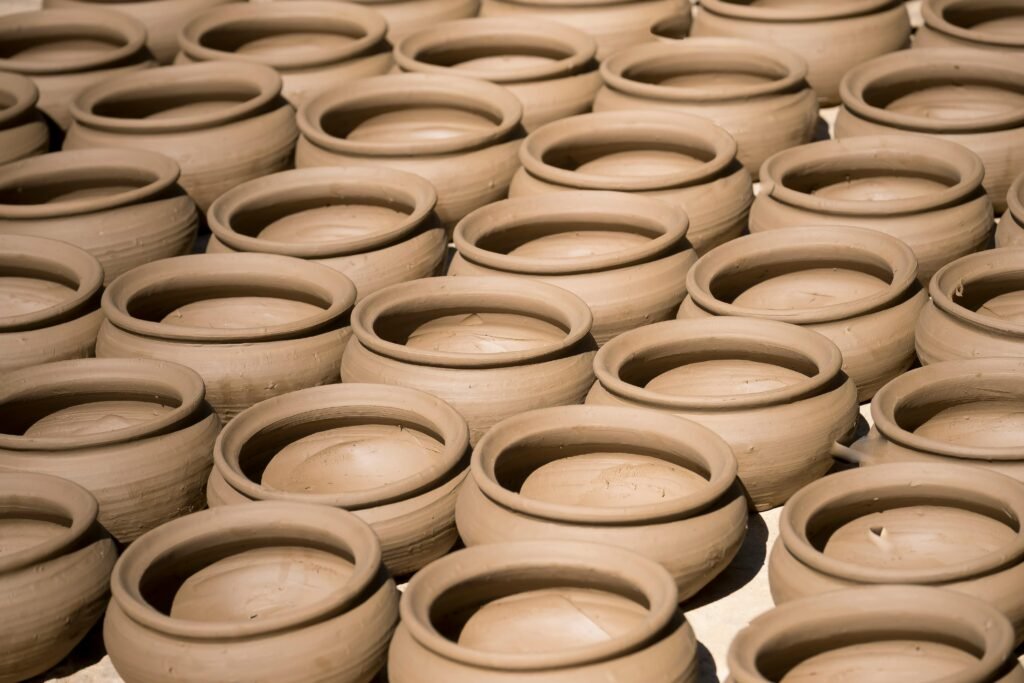Introduction to Indian Pottery
Indian pottery holds a very important place in the rich cultural heritage of India. It is known for variety in its shapes and methods of work. It expresses the styles, materials, and uses of various regions. Be it from the clay figures that symbolized the Indus Valley Civilization to colorful pots used on a daily basis, Indian pottery works well both as useful items as well as a medium for the artistic expression.
Indian culture has pottery for purposes other than aesthetic value. It brings communities together and helps in rituals. Such craftsmen also rely on the methods passed from generation to generation. It means that their knowledge is highly influenced by local materials and creativity skills.
These methods usually involve hand-throwing, coiling, and slab building. Each method requires a particular set of skills and knowledge in the use of materials. Clay is often sourced from riverbeds in the locality. It is hand-shaped, and the product is fired using wood or other environmentally friendly sources to minimize damage to the ecosystem.
Because globalization and industrialization influence traditional arts, potters are changing their ways to incorporate sustainability in their practices. This is significant to the safekeeping of the craft and the environment. Using materials such as clay from nearby and natural dyes for pottery gives the art a greener touch while promoting local businesses. Artisans locally are combining old techniques with new ideas in creating modern pieces. This way there are meeting the present needs while promoting their culture as well.
Materials Used in Sustainable Pottery
The materials used in the craft of Indian pottery have a great influence on sustainability.
Clay
The primary material used is clay, which is locally sourced in most cases. This reduces the carbon footprint by transportation and promotes resource exploitation of resources that are easily available locally. There are various clays such as earthen clay and stoneware clay, which are required for the creation of varying designs and utility products without changing the ecological balance.
Water
The second resource used in creating pottery is water. It is utilized by makers in shaping and molding of their product. The use of local water reduces the environmental footprint that potters could make and saves resources which if used might add to pollution. Apart from the product formation, water is significant for firing since it bakes clay into a hard tough ceramic product. Thus, Indian pottery can be made more sustainable by utilizing local water sources.
Natural Dyes
Natural dyes are very important to making pottery look nice and be good for the environment. The reasons are that they are derived from plants, minerals, and other natural materials, unlike artificial colors, which cannot be as safe for human beings. Potters generally acquire their colors from local plants surrounding them. That is why they are able to be close to their culture but use methods better for Earth.
This promotes the safety of various plants and animals and ensures that the final product is not harmful. This would make it a better choice for nature and people using the final product. Showing their support for sustainability, Indian potters working with local clay, water, and natural dyes, clearly state their commitment. By using nontoxic and renewable sources, these artisans help in saving the environment, and, in doing so, they are also expressing their art.

Eco-friendly Techniques in Pottery Making
Pottery practice in India has evolved with the inclusion of various eco-friendly techniques that, apart from preserving the environment, have sustained traditional craftsmanship.
Air Drying
Among such techniques, air-drying stands out. The technique does not require energy-consuming kilns. Instead, potters use the natural air flow to dry their creations. As the sun dries the pottery, it minimizes energy consumption and, reduces carbon emissions associated with firing in electric or gas kilns. Also, in air-drying, there is more naturally drying of the pot which might leave it to look good eventually.
Pit Firing
Another technique that is gaining popularity with Indian potters is pit firing. It is a very ancient method, which just puts pottery in a pit full of materials that can be burned. The clay is heated specially and gets varying colors and textures, depending upon the fire in the pit. Pit firing connects artisans with their cultural heritage while using low-impact resources. Beautiful results are produced, and it is much more sustainable compared to modern kiln firing because often it uses materials from local sources and also causes less environmental impact.
Clay Recycling
The recycling of clay is also highly important in promoting sustainability in the pottery-making community. Artisans collect waste from their work and reconstitute it into new clay bodies. This way, there is resource conservation and less waste generation. Use of recycled clay saves enormous amounts of new raw material. Thus, it lowers the level of environmental impacts due to extraction and processing of the clay.
Overall, these eco-friendly techniques—the integration of air-drying, pit firing, and recycling clay—highlight the commitment of Indian potters to sustainable practices. Thus, it aligns traditional artistry with modern ecological principles. Adopting such methods ensures the longevity of the craft while safeguarding the environment for future generations.

The Benefits of Sustainable Pottery
The advantages include benefits towards the economy, environment, and culture of adopting sustainable pottery. Sustainability can be significant economic gains for potters. Utilizing local and amicable eco-materials could diminish shipment and import costs. Additionally, pottery makers can also market their products differently when a market is saturated. This can be achieved through focusing on their sustainability practices, which are increasingly being cared for by environmentally concerned customers. This position gives more demand and perhaps higher profits from customers willing to pay a little extra for whatever serves their values.
On the environmental front, sustainable pottery practices help conserve natural resources. The traditional methods of pottery are accompanied by practices that negatively impact the environment, including excessive use of water and reliance on non-renewable sources of energy. Sustainable practices help in ensuring proper use of resources, waste minimization, and also reduce harmful emissions.
The practice of using organic clay that is dried out under air instead of the kilns also reduces energy use. Organic materials decrease harmful by-products that might cause air and soil pollution. These approaches, therefore, advance biodiversity and better soil care through promoting natural fertilizers and pesticides as opposed to synthetics.
Sustainability is something very important to culture also. Pottery is one important aspect of Indian history to reflect the traditional skills and community identifications. By promoting sustainable practices, one relates to Indigenous methods and the preservation of cultural heritage. When consumers become more aware of the impact their purchasing decisions have on the environment and local economies, sustainable pottery choices are an act of cultural appreciation and environmental protection.
Supporting these green practices from potters and consumers will help ensure a long-term sustainable future that enables the art of pottery to grow for generations to come.
Do share your thoughts by commenting below.






